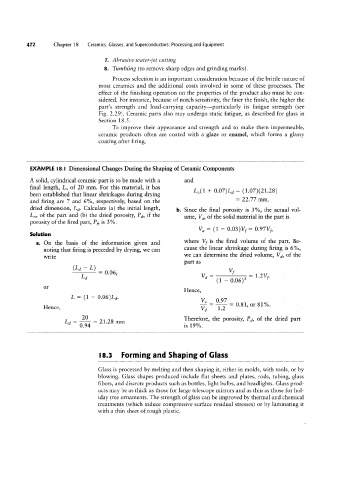Page 492 - 04. Subyek Engineering Materials - Manufacturing, Engineering and Technology SI 6th Edition - Serope Kalpakjian, Stephen Schmid (2009)
P. 492
72 Chapter 18 Ceramics, Glasses, and Superconductors: Processing and Equipment
7. Abrasive water-jet cutting
8. Tumbling (to remove sharp edges and grinding marks).
Process selection is an important consideration because of the brittle nature of
most ceramics and the additional costs involved in some of these processes. The
effect of the finishing operation on the properties of the product also must be con-
sidered. For instance, because of notch sensitivity, the finer the finish, the higher the
part’s strength and load-carrying capacity-particularly its fatigue strength (see
Fig. 2.29). Ceramic parts also may undergo static fatigue, as described for glass in
Section 18.5.
To improve their appearance and strength and to make them impermeable,
ceramic products often are coated with a glaze or enamel, which forms a glassy
coating after firing.
EXAMPLE I8.| Dimensional Changes During the Shaping of Ceramic Components
A solid, cylindrical ceramic part is to be made with a and
final length, L, of 20 mm. For this material, it has LO(1 + 0.07)Ld = (1.07)(21.28)
been established that linear shrinkages during drying
and firing are 7 and 6%, respectively, based on the = 22.77 mm.
dried dimension, Ld. Calculate (a) the initial length, Since the final porosity is 3%, the actual vol-
LO, of the part and (b) the dried porosity, Pd, if the
ume, Va, of the solid material in the part is
porosity of the fired part, Pf, is 3%.
v, = (1 - 0.03)Vf = 0.971/f,
Solution
a. On the basis of the information given and where Vf is the fired volume of the part. Be-
noting that firing is preceded by drying, We can cause the linear shrinkage during firing is 6 %,
we can determine the dried volume, Vd, of the
Write
part as
= 0.06, V Z Vf Z 12V
" (1 - 0.06)3 ` f'
or Hence,
L = (1 ~ 0.06)Ld. Va 097
Hence, E = = 0.81, Or 81 Au.
21 28 mm Therefore, the porosity, Pd, of the dried part
' is 19%.
l8.3 Forming and Shaping of Glass
Glass is processed by melting and then shaping it, either in molds, with tools, or by
blowing. Glass shapes produced include flat sheets and plates, rods, tubing, glass
fibers, and discrete products such as bottles, light bulbs, and headlights. Glass prod-
ucts may be as thick as those for large telescope mirrors and as thin as those for hol-
iday tree ornaments. The strength of glass can be improved by thermal and chemical
treatments (Which induce compressive surface residual stresses) or by laminating it
with a thin sheet of tough plastic.

